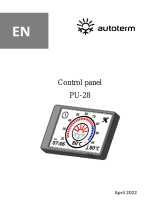Air Top 3500/5000 ST 1Introduction
103
Compliance with §§ 45 and 46 of the Road Vehicle
Licensing Act must be ensured for the installation of fuel
lines and the installation of additional fuel tanks.
The main points from this law:
– Fuel pipes must be designed in such a way that
torsion in the vehicle, movements by the engine and
the like do not have a negative effect on their
durability. They must be protected from mechanical
damage.
– Parts that carry fuel must be protected from heat that
will adversely affect their function and positioned so
that dripping or evaporating fuel cannot collect or
ignite on hot parts or on electrical equipment.
The air heater’s heat exchanger can be used for a
maximum of 10 years and must then be replaced by the
manufacturer or one of its authorised workshops using a
genuine spare part. A label must then be affixed to the
heater showing the date of sale and the wording “Genuine
spare part”.
When you change the heat exchanger it is essential that
you also replace the overheating protection element
(temperature sensor) to prevent possible function faults
caused by using the old temperature sensor.
The Air Top 3500 ST and Air Top 5000 ST air heaters are
prepared for interior installation and sealing direct on the
cabin floor or a cabin wall. Non-release connections must
be used in the interior for combustion air and exhaust
pipes with the accessories available from Webasto.
The seal between the heater mounting and the vehicle
floor must always be installed, otherwise harmful
emissions may get into the interior of the vehicle.
The hot and combustion air intake openings must be
positioned in such a way that no water can ingress into
them if the vehicle drives through a water hazard for which
it has been approved.
The heater must not be installed in the driver’s or
passenger cabin of buses (vehicle classes M2 and M3). If
the heater is nevertheless installed in such a place, the
installation box must be tightly sealed against the vehicle
interior. The installation box must have sufficient external
ventilation to ensure that a maximum temperature of
40 °C is not exceeded in the box. Fault faults may occur if
the temperature exceeds this level.
The heater must be switched off at filling stations and fuel
tank farms because of the risk of explosion.
Wherever inflammable vapours or dust may form (for
example near fuel, coal, wood dust or cereal stores or the
like), the heater must be switched off because of the risk
of explosion.
The neater must not be operated in enclosed areas, such
as garages or workshops without an exhaust emissions
extraction system, not even using the timer, because of
the risk of asphyxiation and poisoning.
In the event of lengthy heavy smoke development,
unusual combustion noise or a smell of fuel, the heater
must be put out of action by removing the fuse and must
not be started again until it has been examined by
Webasto-trained personnel. Liability claims can only be
lodged if the claimant can prove that it has complied with
the servicing and safety instructions.
Installation regulations for Webasto fuel tanks for
supplying fuel to heaters in vehicles:
• The tank must not be installed in the passenger or
driver’s cabin of buses.
• The fuel filler neck must not be inside the passenger
or driver’s cabin in any vehicle.
• Fuel tanks for normal and super grades of petrol must
not be immediately behind the front trim of the vehicle.
They must be separated from the engine in such a
way that in the event of an accident the fuel will not be
expected to ignite. This does not apply to tractor units
with an open driver’s seat.
The fuel lines (Mecanyl hose) must not be immediately
next to the exhaust pipe and must be thermally insulated
if necessary, otherwise they will pose a fire risk.
All pipes that come into contact with fuel must have sealed
connections, they must not be damaged in any way and
the must be checked at regular intervals (at least the
same intervals as an inspection of the vehicle as a whole).
NOTE
If any damage or leaks are found on the fuel line, the
heater must not be used until the damage has been
rectified by an authorised Webasto workshop.
Put the heater out of action by removing the fuse.




















